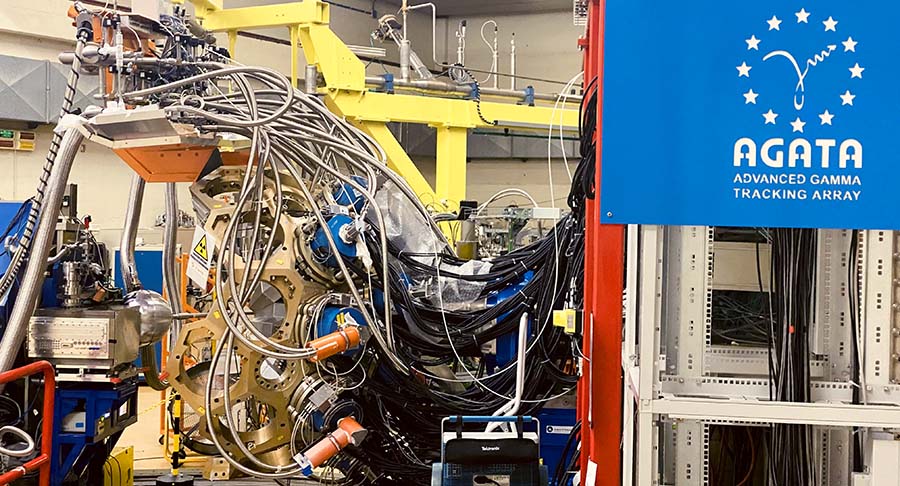- Homepage
- >
- Scientists
- >
- News & Highlights
- >
- 2023
- >
- Focus on AGATA gamma spectrometer
Focus on AGATA gamma spectrometer
AGATA (Advanced GAmma Tracking Array) is a gamma-ray spectrometer that enables to explore with unprecedented precision the structure of exotic nuclei produced in the laboratory by heavy-ion collisions. This jewel in the crown of the European high-resolution gamma-ray spectroscopy community has been the subject of a special issue of EPJA this summer. Emmanuel Clément, researcher at GANIL and AGATA scientific manager for IN2P3, tells us more about the instrument and the international scientific collaboration behind it.
The advent of exotic ion- beam facilities, with low beam intensities and instable, and the need to study reaction channels with low cross sections, have prompted the community to develop gamma-ray detectors with much higher detection efficiency and sensitivity. This has been made possible by the innovative ‘gamma ray tracking’ technique used on AGATA in Europe and GRETA in the United States.
180 hyper-pure Germanium crystals
To achieve this, AGATA is based on segmented hyper-pure Germanium crystals. Once completed, it will contain 180 of them arranged in a sphere around the zone where the nuclear reactions take place. By analysing the shape of the electrical signal induced in the Germanium crystals, it is possible to track back the interactions of each photon inside the crystal with a spatial resolution of a few millimeters, and reconstruct with great precision the initial photon emission from the nuclei produced in nuclear collisions. AGATA has been developed by a collaboration of 13 countries and more than 40 research institutes.

AGATA’s scientific adventure began in 2010 at the Laboratori Nazionali di Legnaro (LNL) in Italy, where it was coupled to the PRISMA large acceptance magnetic spectrometer and other complementary detectors. The first five modules of AGATA used this revolutionary instrument in a series of pioneering experiments with stable beams. AGATA then operated with 8 modules at the Geselshaft für Schwerionenforschung (GSI) in Germany (2012-2014), where it was positioned at the focal plane of the FRagment Separator (FRS) to study reactions induced by relativistic radioactive ion beams.
Mobile detector
The number of detectors continued to grow and AGATA was transferred to the Large National Heavy Ion accelerator (GANIL) in France where 14 modules were used between 2015 and 2021. At GANIL, AGATA was coupled to a series of spectrometers and detection systems including VAMOS++, NEDA, PARIS, FATIMA, MUGAST and exploited reactions with radioactive beams from SPIRAL1.
The return of AGATA to LNL in 2021 marks the start of the next stage of the project, in which it will gradually be expanded to a complete system (4π) of 60 modules. During this campaign at the LNL, AGATA will evolve to cover half of the total solid angle and will carry out measurements exploiting both the intense stable ion beams from the LINAC tandem and ALPI.
90 publications scientifiques
AGATA has already had a huge scientific impact in the nuclear physics community, with more than 90 scientific publications, 110 technical papers and beyond 60 doctoral theses. During its operation in scientific campaigns, the AGATA collaboration has continually increased its performance with improvements in detectors, electronics, pulse shape analysis; data monitoring and analysis software tools.
A review on the progress and achievements has been published in 2023 in a dedicated volume of the European Physical Journal A, AGATA: Advancements in Science and Technology.
